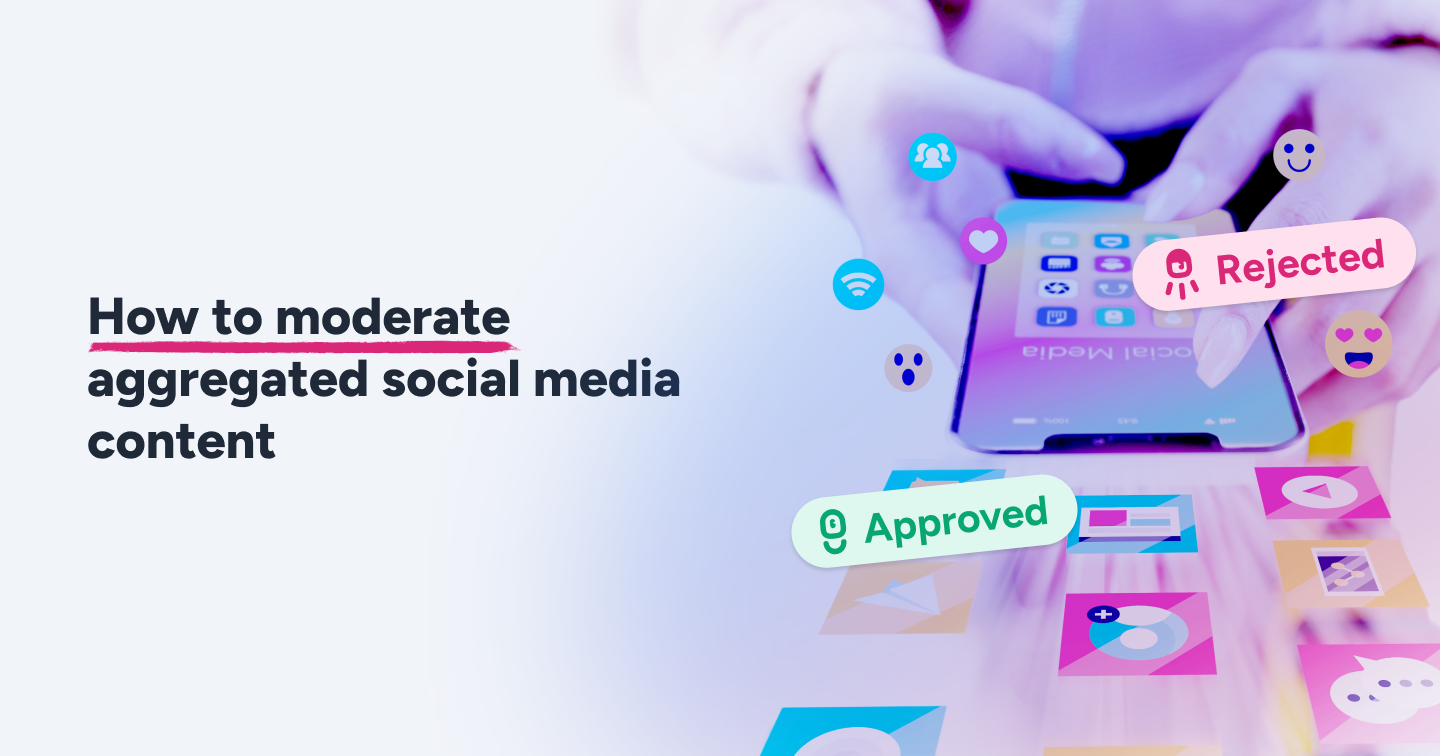Summary
- You cannot dictate what people say and show on the internet. But it’s up to you what you show on your website and other channels. That’s content moderation.
- Moderating socially aggregated content before it goes live removes risky content, keeps content relevant, and makes the feed work for your campaigns.
- Some of the key ways to moderate content effectively include writing a clear policy and brand-safety taxonomy, obtaining explicit rights and giving credit where due, and being mindful of language and cultural differences.
- The best social media aggregator platforms, like Flockler, come with ready-made features for content moderation, so nothing harmful ever shows up on your website’s social wall.
Curating social media on your site feels exciting, but it comes with a pit-in-your-stomach fear: what if something inappropriate sneaks in that tarnishes your brand image?
Because when you pull what people post elsewhere, you borrow the magic and also the mess.
In a letter to creators, Susan Wojcicki, the former CEO of YouTube, described this dilemma, stating that when you create a space designed to welcome many different voices, "some will cross the line."
As Wojcicki points out, even if problematic content is a tiny "fraction of one percent," it has a "hugely outsized impact."
The same principle applies to websites that aggregate social media content. No matter how small the percentage of harmful posts, one bad slip can overshadow all the positive voices you’re trying to highlight.
That's why you need a strong socially-aggregated content moderation strategy to protect your brand reputation while using the voice of the community to your advantage.
In this article, we will walk you through some UGC social content moderation best practices that ensure your aggregated content never crosses the line.
What is content moderation for websites aggregating social media content?
In a nutshell, content moderation of aggregated social media content is the systematic process of reviewing and filtering user-generated content (UGC) against a set of predefined guidelines before displaying it on your website.
It’s how you review posts, images, and videos; approve the good ones; add warnings or blur when needed; and block what doesn’t belong, such as profanity or offensive language.
In practice, moderation is similar to the role of an editor in a magazine. Your job is to feature only high-quality, relevant pieces that perfectly align with your brand’s voice and standards.
But why should you moderate your aggregated social media content
UGC is powerful…but fragile.
When any unwanted post sneaks into a gallery or live wall, the harm is twofold: it tarnishes your brand and shatters audience trust.
A Bazaarvoice study found 75% of consumers are concerned about fake reviews, 69% about fake images, 68% about fake videos, and 63% think brands should be solving the issue. In other words, people expect you to check what shows up under your name.
Here’s another handful of reasons why you shouldn’t take moderation lightly:
- It protects your integrity. Without a proper moderation strategy, your website can quickly become a digital billboard for everything you don't stand for: customer complaints, offensive spam, foul language, or off-brand content that erodes your brand’s integrity. Such content could harm your reputation if displayed.
- Keeps you relevant. Aggregated feeds often pull in noise, such as irrelevant posts, spam, or off-topic chatter. Moderation ensures only the most valuable and engaging content gets shown.
- Makes you compliant. Regulators expect you to keep an eye on what appears next to your name. The FTC’s updated Endorsement Guides (2023) explicitly clarify disclosure rules and note the need for brands to monitor what influencers say on their behalf. If your aggregated feed includes creator posts, sloppy moderation also becomes a compliance problem.
- Strengthens creator relationships. When you ask permission, attribute clearly, or remove content on request, creators collaborate more and often share your features. That steady flow of high-quality UGC becomes an advantage for launches and seasonal campaigns.
- Prevents hijacking. Competitors or trolls can hijack your hashtag or feed to push their own agenda, products, or negative commentary. Moderation blocks that from ever appearing on your website, putting you in total control of the narrative.
Moderation also sustains a safe, welcoming, and trustworthy environment. Users can easily find authentic, high-quality social proof without distractions.
Top best practices for moderating your socially aggregated UGC content
When you publish or advertise content, whether your own or user-generated, you essentially own it in the audience’s eyes.
To act on that responsibility, here are some best practices that will help you moderate content responsibly and ethically:
1. Create a moderation and escalation policy
We have all seen how quickly harmful clips and content can spread after major incidents.
That’s why your moderation team, before everything else, needs clarity on what’s right and what’s not.
This brings us to our point: create a clear, no-fluff content moderation policy that allows moderators to decide what to allow.
Without such a policy, your team can waste precious time in endless back-and-forth, debating whether a post is unconventional or actually offensive.
Here’s what to do:
- Build a short, easy-to-understand content moderation guide for your moderators that they can access easily.
- Clarify what you want to aggregate, what to never publish, and what needs a warning, blur, or extra context. Include practical examples.
- Add a simple decision tree (Keep / Keep with label / Blur / Don’t publish) and an escalation map that names who to reach for legal, PR, or client sign-offs.
The idea is that everyone, from the intern to the veteran, should have the clarity to make the same confident call every single time.
2. Build a simple brand-safety taxonomy and keep it updated
When building your policy, it's crucial to be very clear about the things you won’t publish.
This would probably include profanity, scams, or other sensitive topics that don’t align with your brand.
We recommend creating three lists that your tools and moderators can use:
- a denylist: words and phrases and emojis to block,
- an allowlist: trusted creators, partners, and brand channels, and
- a watchlist: terms that need review because context matters.
This helps you avoid the serious risk of inappropriate or offensive language appearing alongside your brand.
Flocker, one of the best social media aggregator platforms, introduces Garde AI, which automatically flags and hides offensive, spammy, or irrelevant posts based on your predefined rules.

It filters out unsafe or inappropriate content, including offensive language, explicit material, sensitive data, misleading claims, and other off-brand posts.
This ensures that only content that aligns with your brand's voice and values reaches your audience.
3. Prioritize getting user consent and always give proper credit
Just because a user has posted something publicly with your brand's hashtag, you don’t get a free pass to use their content for running ads or marketing campaigns.
While it's true that by signing up for a service like Instagram, users grant the platform a license to share their content in specific ways (like through embeds), this does not automatically transfer those rights to your brand for commercial use.
If you fail to get explicit consent for using UGC in your ads or campaigns, you could be looking at big legal and reputational damage.
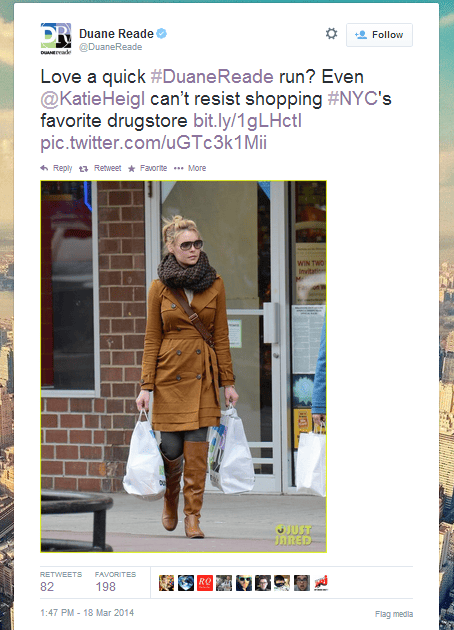
Remember when drugstore chain Duane Reade used a paparazzi photo of actress Katherine Heigl carrying their shopping bags on their social media. Heigl sued the company for unauthorized use of her image.
It created a costly and embarrassing situation for the brand.
To avoid such scuffles, always ask for permission if you plan to use UGC material for ads, marketing campaigns, etc.
You must also tag the user in the post and mention them in the caption; it’s good etiquette and shows respect and appreciation.

Learn from GoPro. Their Million Dollar Challenge not only rewards creators but also prominently features their work. This turns customers into passionate brand advocates.
4. Ensure brand safety and tone of voice with automation
Manually reviewing every mention, image, and video to ensure a post aligns with your brand image and aesthetic is not for the faint of heart. It can quickly overwhelm your team and lead to inconsistent moderation.
Starbucks once faced a setback when its #SpreadTheCheer campaign was exploited to criticize the company in the UK.
Luckily, we live in the age of AI, and you don’t have to go through something similar.
Garde AI from Flockler automatically scans and filters incoming posts for harmful language, off-brand visuals, and inappropriate content before they ever reach your site.
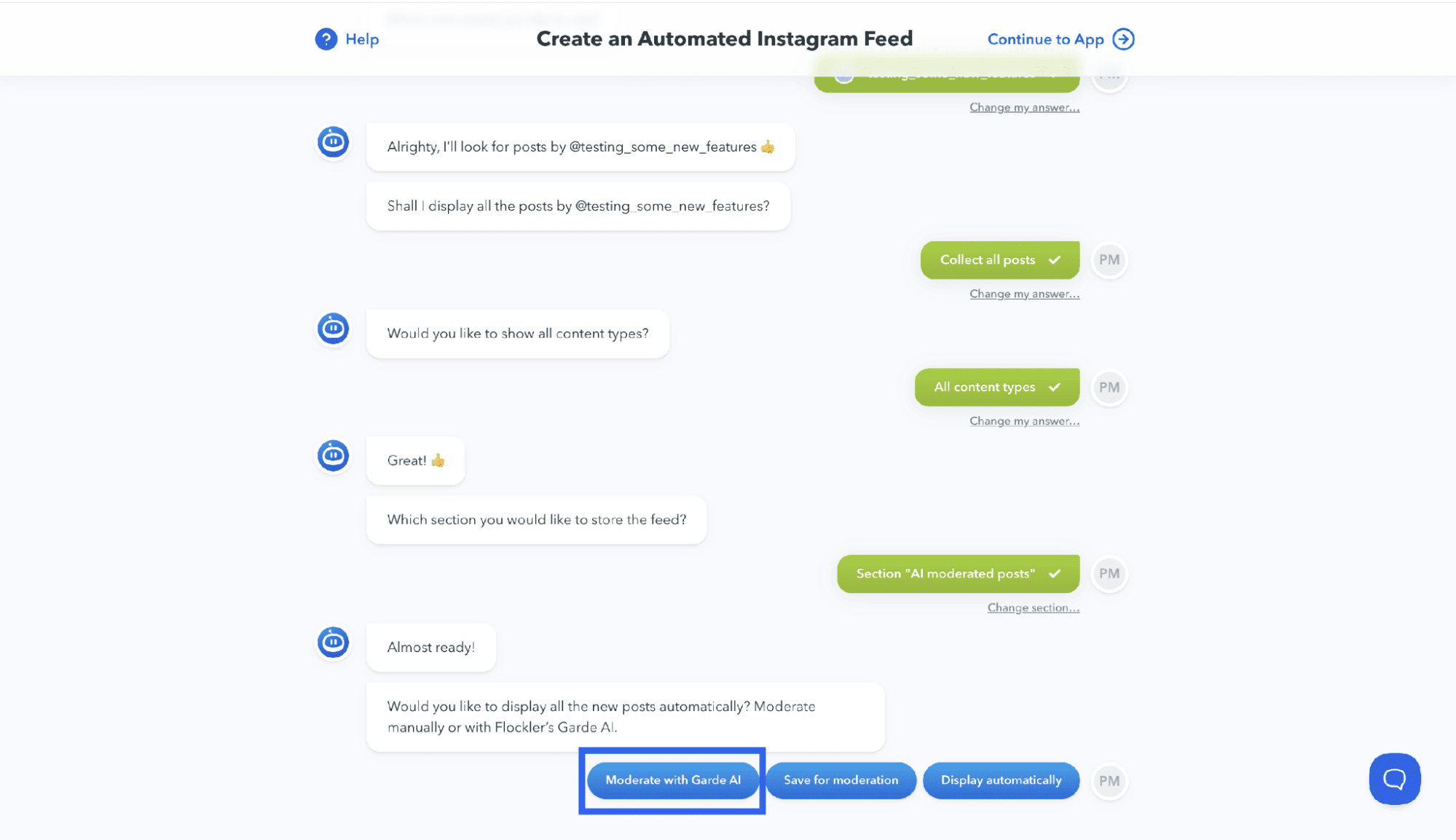
This means your team can focus on highlighting authentic, positive voices while AI quietly protects your brand from any backlash.
5. Localize moderation for global campaigns
When your brand speaks to the world, a single dictionary is never enough. A campaign that works powerfully in one country can fall flat or, worse, be deeply offensive in another due to differences in language, culture, and symbolism.
To build genuine connections and avoid cultural insensitivity, your moderation strategy must be as diverse as the communities you serve, ideally using native speakers who understand the local nuance.
Consider what happened with Dolce & Gabbana in China.

Their campaign in China, which portrayed cultural stereotypes, was widely criticized and quickly taken down, showing how easily cultural missteps can damage brand perception.
That’s why, without localized reviewers, your on-site feed could quietly fill with sarcasm, memes, and pointed criticisms that your global team misses. A local moderator would spot the tone, flag the double meanings, and identify missteps before your homepage becomes a highlight reel of your mistakes.
6. Maintain a high bar for content quality and aesthetics
Your aggregated content feed is a direct mirror of your brand's standards.
A messy, unprofessional, or low-quality feed will actively detract from your brand image. You need to not only moderate for safety but also to curate for quality.
This means ensuring that the submissions are high-resolution, the videos are well-lit, and the text is well-written and relevant.
National Geographic is a good example of a brand that excels at this. Their user-submitted Photo of the Day is always of breathtaking quality, reinforcing their reputation for stunning visual storytelling.
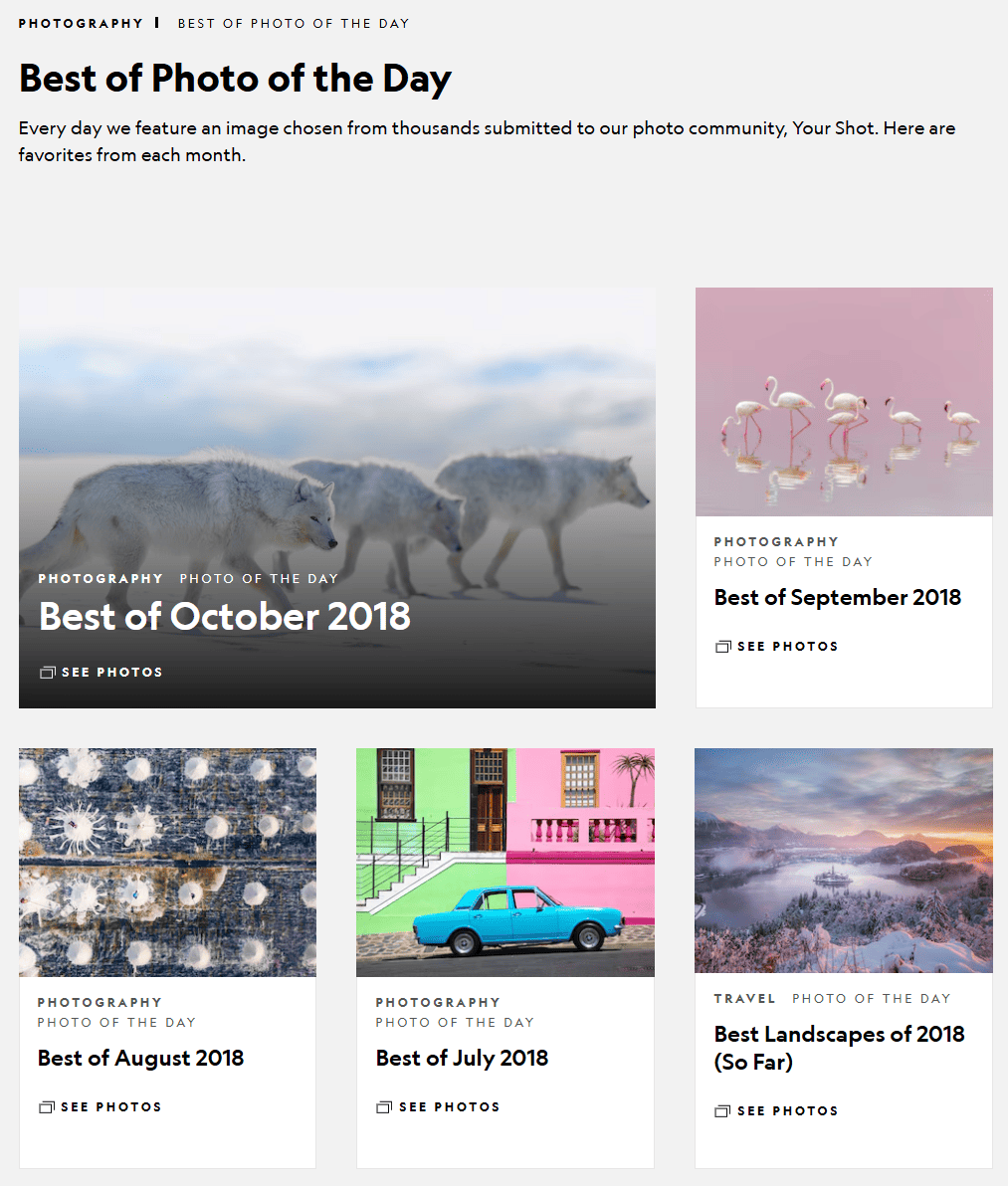
If you’re dealing with a high volume of submissions, an AI-powered assistant can make all the difference.
Flocker's Garde AI helps maintain a polished and consistent brand presence by automatically filtering out low-quality or off-brand posts. It even lets agencies simplify their moderation process across clients, eliminating the chances of human error while scaling reports.
With Garde, you can easily uphold a high aesthetic standard and keep your social media wall a beautiful and engaging representation of your brand.
7. Audit and update your moderation rules regularly
Your moderation policy needs to adapt as quickly as the internet itself. The slang, memes, and emoji combinations that are popular today can become outdated or, worse, co-opted for harmful purposes tomorrow. A moderation system built last year is already obsolete.
Without an audit and an update to their moderation rules to flag the new phrase, their family-friendly campaign could have become an unintentional political battleground.
That’s why you need to conduct regular, quarterly reviews to stay culturally intelligent and protect your brand from being blindsided.
8. Build your safety nets by planning for takedowns, expiry, and graceful fallbacks
The work isn't over once your social media wall is live.
Creators might delete their original posts, brand campaigns change, and online sentiment can turn in an instant. You must plan for these changes by building three essential safety nets.
- First, you need a kill switch, a single-click function to hide your UGC display site-wide immediately. This is a must for damage control if a hashtag gets hijacked.
- Second, implement auto-expiry rules that automatically remove content after a set period, such as 90 days. You don’t want stale or outdated posts to linger on key pages.
- Third, design graceful fallbacks. If a user deletes their post and breaks the embed, your site shouldn't show a jarring error message. Instead, it should default to a neutral brand image or simply hide the empty space.
Imagine if an automated feed had pulled that tweet onto their homepage. A kill switch would have allowed their team to instantly disable the UGC section, containing the damage, and prevent a terrible mistake from being amplified on their own platform.
Automate and simplify your moderation process with Garde AI
We’ve discussed Garde in other contexts already, but in the context of safeguarding UGC at scale and doing so without incurring hours of content moderation, the tool warrants a closer examination. It’s fast, it’s native to Flockler, and it cuts real operational pain.
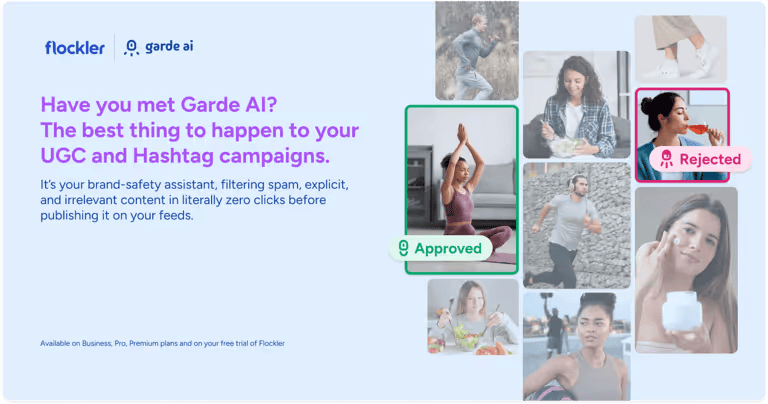
Garde AI is Flockler’s built-in moderation assistant, designed to keep your social walls and UGC displays clean, safe, and on-brand. It automatically flags and hides posts that appear offensive, irrelevant, or spammy, ensuring the content you showcase genuinely helps your brand instead of risking damage.
How does it help with moderation, you ask?
- It cuts the manual grind by screening incoming UGC and hashtag pulls before anything goes live and maintains brand-safe walls and event screens.
- It flags and removes profanity, off-topic promos, low-quality or misleading posts, across text and images, so your feed stays useful and tidy.
- It lets humans stay in charge: anything Garde flags is reviewable, and you can still approve or publish manually when needed.
Inside Flockler, you can choose a moderation mode per feed: publish automatically, review in an inbox, or enable Garde AI to filter automatically. Teams on Business, Pro, and Premium plans can enable Garde AI directly in their workflow, without any extra tools.
Book a demo with Flockler, and we’ll walk you through Garde AI on your use case.
FAQs
What's the best way to kickstart a UGC campaign if our brand doesn't get many organic mentions?
To generate your first wave of content, launch a dedicated campaign with a unique hashtag and a compelling prize. As submissions roll in, using one of the best social media aggregators for businesses is key for management.
Tools like Flockler help you easily collect and display this new content on your site. These tools turn an initial campaign push into a lasting asset that encourages future organic sharing and builds a strong community foundation.
Besides getting permission, what are the legal nuances of using someone else's content? Do I own it after they say yes?
Getting permission grants you a license to use the content, not ownership. The creator always retains their copyright. Your Terms and Conditions should specify exactly how and where you can use the content (like website, ads) and for how long.
Be mindful of photos that include other identifiable people or licensed music, as this can complicate usage rights. Always operate from a clear, opt-in agreement to protect both your brand and the creator.
Should we ever display negative comments or reviews in our aggregated feed?
While you should always remove inapt or spammy content, showing constructive criticism can build trust. A feed with 100% positive reviews might feel inauthentic.
Displaying a legitimate negative comment along with your polite and helpful public response shows transparency and excellent customer service. It shows potential customers that you are a real, responsive brand that listens to its community, which can be more powerful than a generic positive review.
